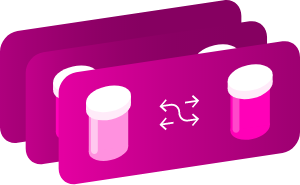Identification
- Summary
-
Potassium gluconateis a potassium supplement indicated in the treatment and prevention of hypokalemia.
- Generic Name
- Potassium gluconate
- DrugBank Accession Number
- DB13620
- Background
-
Potassium gluconate is a salt ofPotassium cation和由美国食品和药物管理局列为食品添加剂7. It is also used as a potassium supplement10.
Potassium is an essential nutrient. It is the most abundant cation in the intracellular fluid, where it plays a key role in maintaining cell function1.
In dietary supplements, potassium is often present as potassium chloride, but many other forms—including potassium citrate, phosphate, aspartate, bicarbonate, andgluconate—are also used5. Potassium gluconate is believed to be more palatable and non-acidifying than potassium chloride (KCl)11.
- Type
- Small Molecule
- Groups
- Approved
- Structure
- Weight
-
Average: 234.245
Monoisotopic: 234.01418418 - Chemical Formula
- C6H11KO7
- Synonyms
-
- potassium D-gluconate
- Potassium gluconate
- External IDs
-
- E-577
- INS NO.577
- INS-577
Pharmacology
- Indication
-
Because of potassium’s wide-ranging roles in the body, low intakes can increase the risk of illness8.
Potassium supplements are indicated to prevent hypokalemia in patients who would be at particular risk if hypokalemia were to develop (e.g., digitalis treated patients with significant cardiac arrhythmias). Potassium deficiency occurs when the rate of loss through renal excretion and/or loss from the gastrointestinal tract is higher than the rate of potassium intake. In addition to serving as a preventative supplement, potassium gluconate also serves as a treatment for decreased potassium levels8,4,10.
 Reduce drug development failure ratesBuild, train, & validate machine-learning models
Reduce drug development failure ratesBuild, train, & validate machine-learning models
with evidence-based and structured datasets.Build, train, & validate predictive machine-learning models with structured datasets. - Associated Conditions
- Contraindications & Blackbox Warnings
-
 Avoid life-threatening adverse drug eventsImprove clinical decision support with information oncontraindications & blackbox warnings, population restrictions, harmful risks, & more.Avoid life-threatening adverse drug events & improve clinical decision support.
Avoid life-threatening adverse drug eventsImprove clinical decision support with information oncontraindications & blackbox warnings, population restrictions, harmful risks, & more.Avoid life-threatening adverse drug events & improve clinical decision support. - Pharmacodynamics
-
Potassium is an essential nutrient. It is the most abundant cation in intracellular fluid, where it plays a key role in maintaining cell function, especially in excitable cells such as skeletal muscles, the heart, and nerves3. Increases in interstitial potassium play an important role in eliciting rapid vasodilation, allowing for blood flow to increase in exercising muscle13.
- Mechanism of action
-
Potassium is the most abundant cation (approximately 150 to 160 mEq per liter) within human cells. Intracellular sodium content is relatively low. In the extracellular fluid, sodium predominates and the potassium content is low (3.5 to 5 mEq per liter). A membrane-bound enzyme, sodium-potassium–activated adenosinetriphosphatase (Na +K +ATPase), actively transports or pumps sodium out and potassium into cells to maintain the concentration gradients. The intracellular to extracellular potassium gradients are necessary for nerve impulse signaling in such specialized tissues as the heart, brain, and skeletal muscle, and for the maintenance of physiologic renal function and maintenance of acid-base balance. High intracellular potassium concentrations are necessary for numerous cellular metabolic processes8.
Intracellular K+ serves as a reservoir to limit the fall in extracellular potassium concentrations occurring under pathologic conditions with loss of potassium from the body13.
- Absorption
-
Potassium is rapidly and well absorbed. A 2016 dose-response trial found that humans absorb about 94% of potassium gluconate in supplements, and this absorption rate is similar to that of potassium from potatoes2.
- Volume of distribution
-
Distribution is largely intracellular, but it is the intravascular concentration that is primarily responsible for toxicity6.
- Protein binding
-
Not Available
- Metabolism
- Not Available
- Route of elimination
-
90% of potassium is eliminated via the kidneys. A small amount is eliminated in feces and sweat6.
- Half-life
-
Not Available
- Clearance
-
钾是肾小球滤过的自由the kidney. The majority of filtered potassium is reabsorbed in the proximal tubule and loop of Henle. Less than 10% of the filtered load reaches the distal nephron. In the proximal tubule of the nephron, potassium absorption is mainly passive and proportional to Na+ and water. K+ reabsorption in the thick ascending limb of Henle occurs through both transcellular and paracellular pathways. The transcellular component is regulated by potassium transport on the apical membrane Na+-K+-2Cl− cotransporter. The secretion of potassium begins in the early distal convoluted tubule of the nephron and progressively increases along the distal nephron into the cortical collecting duct. Most urinary K+ can be accounted for by electrogenic K+ secretion mediated by principal cells in the initial collecting duct and the cortical collecting duct. An electroneutral K+ and Cl− cotransport mechanism is also present on the apical surface of the distal nephron. Under conditions of potassium deficiency, reabsorption of the cation occurs in the collecting duct. This process is regulated by the upregulation in the apically located H+-K+-ATPase on α-intercalated cells13.
- Adverse Effects
-
 Improve decision support & research outcomesWith structured adverse effects data, including:blackbox warnings, adverse reactions, warning & precautions, & incidence rates.Improve decision support & research outcomes with our structured adverse effects data.
Improve decision support & research outcomesWith structured adverse effects data, including:blackbox warnings, adverse reactions, warning & precautions, & incidence rates.Improve decision support & research outcomes with our structured adverse effects data. - Toxicity
-
交流ute oral toxicity (LD50): 9100 mg/kg in the mouseMSDS
Toxicity from overdose is rare but may result from intentional ingestion of potassium. Iatrogenic overdoses may occur6.
Local irritation after ingestion causes GI upset. Severe hyperkalemia after large IV or oral overdoses causes muscular dysfunction including weakness, paralysis, cardiac dysrhythmias, and rarely death6.
Mild to moderate toxicity
Nausea, vomiting, diarrhea, paresthesias, and muscle cramps are common. Rarely, gastrointestinal bleed may occur.
Severe toxicity
In severe toxicity, muscular weakness progressing to paralysis may occur. Cardiac arrhythmia often occur at concentrations greater than 8 mEq/L and death from cardiac arrest at concentrations of 9 to 12 mEq/L or higher. Characteristic ECG findings occur in the following order: peaked T waves, QRS complex blends into the T wave, PR interval prolongation, P wave is lost and ST segments depress, merging S and T waves, and finally, sine waves. The presence of the sine wave is a near terminal event, signaling that hemodynamic collapse and cardiac arrest are near. As serum hyperkalemia is corrected towards normal concentrations, the ECG changes resolve in reverse order6.
- Pathways
- Not Available
- Pharmacogenomic Effects/ADRsBrowse all" title="" id="snp-actions-info" class="drug-info-popup" href="javascript:void(0);">
- Not Available
Interactions
- Drug InteractionsLearn More" title="" id="structured-interactions-info" class="drug-info-popup" href="javascript:void(0);">
-
This information should not be interpreted without the help of a healthcare provider. If you believe you are experiencing an interaction, contact a healthcare provider immediately. The absence of an interaction does not necessarily mean no interactions exist.
Drug Interaction Integrate drug-drug
interactions in your software交流ebutolol Potassium gluconate may increase the hyperkalemic activities of Acebutolol. 交流eclofenac Potassium gluconate may increase the hyperkalemic activities of Aceclofenac. 交流emetacin Potassium gluconate may increase the hyperkalemic activities of Acemetacin. 交流etylsalicylic acid Potassium gluconate may increase the hyperkalemic activities of Acetylsalicylic acid. Alclofenac Potassium gluconate may increase the hyperkalemic activities of Alclofenac. Aliskiren Potassium gluconate may increase the hyperkalemic activities of Aliskiren. Amiloride The risk or severity of hyperkalemia can be increased when Potassium gluconate is combined with Amiloride. Aminophenazone Potassium gluconate may increase the hyperkalemic activities of Aminophenazone. Amiodarone Potassium gluconate may increase the hyperkalemic activities of Amiodarone. Amlodipine Potassium gluconate may increase the hyperkalemic activities of Amlodipine.  Identify potential medication risksEasily compare up to 40 drugs with our drug interaction checker.Get severity rating, description, and management advice.Learn more
Identify potential medication risksEasily compare up to 40 drugs with our drug interaction checker.Get severity rating, description, and management advice.Learn more - Food Interactions
- No interactions found.
Products
-
 Drug product information from 10+ global regionsOur datasets provide approved product information including:
Drug product information from 10+ global regionsOur datasets provide approved product information including:
dosage, form, labeller, route of administration, and marketing period.交流cess drug product information from over 10 global regions. - International/Other Brands
- Gluconsan-K
- Over the Counter Products
-
Name Dosage Strength Route Labeller Marketing Start Marketing End Region Image Kaon Elixir 4.68 g / 15 mL Oral Pfizer Canada Ulc 1995-12-31 2006-08-02 Canada Potassium 99 - Caplet Tablet 99 mg Oral Health Wise Nutrition Inc. 1995-12-31 2002-07-18 Canada Potassium Gluconate Tab 550mg USP Tablet 92 mg / tab Oral Pharmavite 1991-12-31 2000-08-24 Canada Potassium Gluconate Tablets 99mg USP Tablet 99 mg / tab Oral Royal Bodycare Canada Inc. 1992-12-31 2001-08-07 Canada Potassium Rougier Liquid 780 mg / 15 mL Oral Rougier Pharma Division Of Ratiopharm Inc 1965-12-31 2001-09-05 Canada Potassium Tab 8.3mg Tablet 50 mg / tab Oral Bio Vita 1987-12-31 1996-09-09 Canada Potassium Tab 99mg Tablet 99 mg Oral Rheingold Food International Ltd. 1985-12-31 2007-07-26 Canada - Mixture Products
-
Name Ingredients Dosage Route Labeller Marketing Start Marketing End Region Image Cal-mag Plus K, Mn and Zn Caplets Potassium gluconate(5 mg / tab)+Calcium carbonate(175 mg / tab)+Magnesium oxide(87.5 mg / tab)+Manganese gluconate(2.5 mg / tab)+Zinc oxide(2.5 mg / tab) Tablet Oral Health Wise Nutrition Inc. 1994-12-31 1999-08-13 Canada Flexadyn Tab Potassium gluconate(50 mg / tab)+Copper gluconate(.1 mg / tab)+Cyanocobalamin(100 mcg / tab)+Magnesium carbonate(100 mg / tab)+Pyridoxine hydrochloride(50 mg / tab)+Vitamin A(1000 unit / tab) Tablet Oral Nutri Dyn Products Ltd. 1976-12-31 1996-09-09 Canada Formula BP Potassium gluconate(15 mg / tab)+Magnesium(10 mg / tab)+Manganese(5 mg / tab)+Pyridoxine hydrochloride(33.3 mg / tab) Tablet Oral Nutrivention Nutritional Products Not applicable Not applicable Canada Iode-potassium Potassium gluconate(75 mg)+Potassium Iodide(0.15 mg) Tablet Oral Gamme Nature 1999-12-30 2004-07-26 Canada Men's Multi Master Formula Potassium gluconate(1.6 mg)+Biotin(50 mcg)+Calcium ascorbate(200 mg)+Cholecalciferol(200 unit)+Choline bitartrate(25 mg)+Chromic chloride(19.5 mcg)+Copper gluconate(1 mg)+Cyanocobalamin(20 mcg)+Folic acid(0.20 mg)+Inositol(25 mg)+Iodine(0.15 mg)+Manganese gluconate(0.5 mg)+Nicotinamide(50 mg)+Calcium pantothenate(30 mg)+Pyridoxine hydrochloride(30 mg)+Riboflavin(30 mg)+Sodium selenite(50 mcg)+Thiamine hydrochloride(30 mg)+Vitamin A palmitate(3500 unit)+Zinc gluconate(10 mg)+艾尔pha-Tocopherol succinate(100 unit) Tablet Oral Pro Ma Systems 1998-10-31 2008-07-04 Canada Multivitamins and Minerals for Young Men Potassium gluconate(3.75 mg / tab)+Ascorbic acid(37.5 mg / tab)+Beta carotene(2500 unit / tab)+Biotin(6.25 mcg / tab)+Calcium Phosphate(80 mg / tab)+Calcium Phosphate(62.5 mg / tab)+Cholecalciferol(100 unit / tab)+Choline bitartrate(6.25 mg / tab)+Cyanocobalamin(6.25 mcg / tab)+Folic acid(0.2 mg / tab)+Inositol(6.25 mg / tab)+Magnesium oxide(25 mg / tab)+Manganese gluconate(0.5 mg / tab)+Niacin(6.25 mg / tab)+Calcium pantothenate(6.25 mg / tab)+Potassium Iodide(0.025 mg / tab)+Pyridoxine hydrochloride(5.25 mg / tab)+Racemethionine(6.25 mg / tab)+Riboflavin(6.25 mg / tab)+Thiamine hydrochloride(5 mg / tab)+Vitamin E(12.5 unit / tab)+Zinc citrate(2.5 mg / tab) Tablet Oral Quest Vitamins A Div Of Purity Life Health Products 2001-01-31 2004-06-29 Canada Multivitamins and Minerals for Young Women Potassium gluconate(3.75 mg / tab)+Ascorbic acid(37.5 mg / tab)+Beta carotene(2500 unit / tab)+Biotin(6.25 mcg / tab)+Calcium Phosphate(80 mg / tab)+Calcium Phosphate(62.5 mg / tab)+Cholecalciferol(100 unit / tab)+Choline bitartrate(6.25 mg / tab)+Copper gluconate(0.5 mg / tab)+Cyanocobalamin(6.25 mcg / tab)+Ferrous fumarate(3.75 mg / tab)+Folic acid(0.2 mg / tab)+Inositol(6.25 mg / tab)+Magnesium oxide(25 mg / tab)+Manganese gluconate(0.5 mg / tab)+Niacin(6.25 mg / tab)+Calcium pantothenate(6.25 mg / tab)+Potassium Iodide(0.025 mg / tab)+Pyridoxine hydrochloride(5.25 mg / tab)+Racemethionine(6.25 mg / tab)+Riboflavin(6.25 mg / tab)+Thiamine hydrochloride(5 mg / tab)+Vitamin E(12.5 unit / tab)+Zinc citrate(2.5 mg / tab) Tablet Oral Quest Vitamins A Div Of Purity Life Health Products 2001-01-31 2004-06-29 Canada Neutral C + Coenzyme Q10 Plus Vitamins & Minerals Potassium gluconate(3 mg / cap)+Aminobenzoic acid(15 mg / cap)+Calcium ascorbate(320 mg / cap)+Cyanocobalamin(150 mcg / cap)+Folic acid(0.5 mg / cap)+Magnesium oxide(50 mg / cap)+Pyridoxine hydrochloride(25 mg / cap)+Sodium selenite(40 mcg / cap)+Ubidecarenone(10 mg / cap) Capsule Oral New Vision Nutritionals Company 1998-06-07 2002-11-20 Canada Organic Minerals Tablet Potassium gluconate(30 mg)+Calcium carbonate(333.3 mg)+Chromic chloride(16.66 mcg)+Copper gluconate(0.66 mg)+Ferrous fumarate(6 mg)+Magnesium oxide(133.3 mg)+Manganese gluconate(3.33 mg)+Potassium Iodide(0.05 mg)+Sodium selenite(66.66 mcg)+Sodium molybdate(8.33 mcg)+Zinc gluconate(6.66 mg) Tablet Oral Pharmetics (2011) Inc. 2003-09-20 2009-07-30 Canada Potassium Plus Vit B Complex Potassium gluconate(450 mg / tab)+Nicotinamide(10 mg / tab)+Calcium pantothenate(2 mg / tab)+Potassium Iodide(100 mcg / tab)+Riboflavin(1.2 mg / tab)+Thiamine hydrochloride(1 mg / tab) Tablet Oral Anabolic Laboratories Inc. 1981-12-31 1996-10-02 Canada
Categories
- ATC Codes
- A12BA05 — Potassium gluconate
- Drug Categories
- Chemical TaxonomyProvided byClassyfire
-
- Description
- This compound belongs to the class of organic compounds known as sugar acids and derivatives. These are compounds containing a saccharide unit which bears a carboxylic acid group.
- Kingdom
- Organic compounds
- Super Class
- Organic oxygen compounds
- Class
- Organooxygen compounds
- Sub Class
- Carbohydrates and carbohydrate conjugates
- Direct Parent
- Sugar acids and derivatives
- Alternative Parents
- Medium-chain hydroxy acids and derivatives/Medium-chain fatty acids/Beta hydroxy acids and derivatives/Hydroxy fatty acids/Monosaccharides/Secondary alcohols/Carboxylic acid salts/Polyols/Carboxylic acids/Monocarboxylic acids and derivatives show 6 more
- Substituents
- Alcohol/Aliphatic acyclic compound/Beta-hydroxy acid/Carbonyl group/Carboxylic acid/Carboxylic acid derivative/Carboxylic acid salt/Fatty acid/Fatty acyl/Gluconic_acid show 15 more
- Molecular Framework
- Aliphatic acyclic compounds
- External Descriptors
- Not Available
- Affected organisms
-
- Humans and other mammals
Chemical Identifiers
- UNII
- 12H3K5QKN9
- CAS number
- 299-27-4
- InChI Key
- HLCFGWHYROZGBI-JJKGCWMISA-M
- InChI
-
InChI=1S/C6H12O7.K/c7-1-2(8)3(9)4(10)5(11)6(12)13;/h2-5,7-11H,1H2,(H,12,13);/q;+1/p-1/t2-,3-,4+,5-;/m1./s1
- IUPAC Name
-
potassium (2R,3S,4R,5R)-2,3,4,5,6-pentahydroxyhexanoate
- SMILES
-
[K+].[H][C@@](O)(CO)[C@@]([H])(O)[C@]([H])(O)[C@@]([H])(O)C([O-])=O
References
- General References
-
- Stone MS, Martyn L, Weaver CM: Potassium Intake, Bioavailability, Hypertension, and Glucose Control. Nutrients. 2016 Jul 22;8(7). pii: nu8070444. doi: 10.3390/nu8070444. [Article]
- Macdonald-Clarke CJ, Martin BR, McCabe LD, McCabe GP, Lachcik PJ, Wastney M, Weaver CM: Bioavailability of potassium from potatoes and potassium gluconate: a randomized dose response trial. Am J Clin Nutr. 2016 Aug;104(2):346-53. doi: 10.3945/ajcn.115.127225. Epub 2016 Jul 13. [Article]
- Potassium Gluconate, PubChem [Link]
- POTASSIPOWDER- potassium gluconate powder [Link]
- NIH Potassium Fact Sheet for Health Professionals [Link]
- NIH Toxnet, Potassium [Link]
- Everything Added to Food in the United States (EAFUS) Print Share E-mail [Link]
- Potassium Supplements (Systemic) [Link]
- POTASSIUM GLUCONATE [Link]
- DRUG: Potassium gluconate [Link]
- Overview: Potassium Gluconate [Link]
- 补充钾、口腔路线,梅奥诊所(Link]
- Regulation of Potassium Homeostasis [Link]
- INVIMA Product Authorization: Ion-K (potassium gluconate) oral solution [Link]
- External Links
-
- KEGG Drug
- D01298
- PubChem Compound
- 16760467
- PubChem Substance
- 347829307
- ChemSpider
- 8931
- 89903
- ChEBI
- 32032
- ChEMBL
- CHEMBL2106978
- Wikipedia
- Potassium_gluconate
- MSDS
-
Download (47.3 KB)
Clinical Trials
- Clinical TrialsLearn More" title="" id="clinical-trials-info" class="drug-info-popup" href="javascript:void(0);">
-
Phase Status Purpose Conditions Count 1, 2 Unknown Status Treatment Attention Deficit Hyperactivity Disorder (ADHD) 1
Pharmacoeconomics
- Manufacturers
-
Not Available
- Packagers
-
Not Available
- Dosage Forms
-
Form Route Strength Tablet Oral Solution Oral 31.2 g Elixir Oral 4.68 g / 15 mL Capsule Oral Tablet Oral 99 mg Tablet Oral 92 mg / tab Tablet Oral 99 mg / tab Liquid Oral 780 mg / 15 mL Tablet Oral 50 mg / tab Tablet, extended release Oral - Prices
- Not Available
- Patents
- Not Available
Properties
- State
- Solid
- Experimental Properties
-
Property Value Source melting point (°C) 180 MSDS - Predicted Properties
-
Property Value Source Water Solubility 833.0 mg/mL ALOGPS logP -1.9 ALOGPS logP -3.4 Chemaxon logS 0.55 ALOGPS pKa (Strongest Acidic) 3.39 Chemaxon pKa (Strongest Basic) -3 Chemaxon Physiological Charge -1 Chemaxon Hydrogen Acceptor Count 7 Chemaxon Hydrogen Donor Count 5 Chemaxon Polar Surface Area 141.28 Å2 Chemaxon Rotatable Bond Count 5 Chemaxon Refractivity 49.11 m3·mol-1 Chemaxon Polarizability 16.62 Å3 Chemaxon Number of Rings 0 Chemaxon Bioavailability 1 Chemaxon Rule of Five Yes Chemaxon Ghose Filter No Chemaxon Veber's Rule No Chemaxon MDDR-like Rule No Chemaxon - Predicted ADMET Features
- Not Available
Spectra
- Mass Spec (NIST)
- Not Available
- Spectra
-
Spectrum Spectrum Type Splash Key Predicted GC-MS Spectrum - GC-MS Predicted GC-MS Not Available
Enzymes
- Kind
- Protein
- Organism
- Humans
- Pharmacological action
-
No
- 交流tions
-
SubstrateInducer
- General Function
- Transporter activity
- Specific Function
- May be involved in forming the receptor site for cardiac glycoside binding or may modulate the transport function of the sodium ATPase.
- Gene Name
- FXYD2
- Uniprot ID
- P54710
- Uniprot Name
- Sodium/potassium-transporting ATPase subunit gamma
- Molecular Weight
- 7283.265 Da
References
Transporters
- Kind
- Protein
- Organism
- Humans
- Pharmacological action
-
No
- 交流tions
-
Substrate
- General Function
- Steroid hormone binding
- Specific Function
- This is the catalytic component of the active enzyme, which catalyzes the hydrolysis of ATP coupled with the exchange of sodium and potassium ions across the plasma membrane. This action creates th...
- Gene Name
- ATP1A1
- Uniprot ID
- P05023
- Uniprot Name
- Sodium/potassium-transporting ATPase subunit alpha-1
- Molecular Weight
- 112895.01 Da
References
- Welling PA: Rare mutations in renal sodium and potassium transporter genes exhibit impaired transport function. Curr Opin Nephrol Hypertens. 2014 Jan;23(1):1-8. doi: 10.1097/01.mnh.0000437204.84826.99. [Article]
- Kind
- Protein
- Organism
- Humans
- Pharmacological action
-
No
- 交流tions
-
Substrate
- General Function
- 钠,钾,氯同向转运活动
- Specific Function
- Electrically silent transporter system. Mediates sodium and chloride reabsorption. Plays a vital role in the regulation of ionic balance and cell volume.
- Gene Name
- SLC12A1
- Uniprot ID
- Q13621
- Uniprot Name
- Solute carrier family 12 member 1
- Molecular Weight
- 121449.13 Da
References
- Welling PA: Rare mutations in renal sodium and potassium transporter genes exhibit impaired transport function. Curr Opin Nephrol Hypertens. 2014 Jan;23(1):1-8. doi: 10.1097/01.mnh.0000437204.84826.99. [Article]
- Kind
- Protein group
- Organism
- Humans
- Pharmacological action
-
No
- 交流tions
-
Substrate
- General Function
- Sodium:potassium-exchanging atpase activity
- Specific Function
- Catalyzes the hydrolysis of ATP coupled with the exchange of H(+) and K(+) ions across the plasma membrane. Responsible for acid production in the stomach.
Components:
| Name | UniProt ID |
|---|---|
| Potassium-transporting ATPase alpha chain 1 | P20648 |
| Potassium-transporting ATPase subunit beta | P51164 |
References
- Gumz ML, Lynch IJ, Greenlee MM, Cain BD, Wingo CS: The renal H+-K+-ATPases: physiology, regulation, and structure. Am J Physiol Renal Physiol. 2010 Jan;298(1):F12-21. doi: 10.1152/ajprenal.90723.2008. Epub 2009 Jul 29. [Article]
Drug created at June 23, 2017 20:45 / Updated at October 09, 2021 02:49




